Diclofenac sodium
Synonym(s):2-[(2,6-Dichlorophenyl)amino]benzeneacetic acid sodium salt;2-[(2,6-Dichlorophenyl)amino]benzeneacetic Acid, Na;Diclofenac Sodium - CAS 15307-79-6 - Calbiochem;Diclofenac sodium salt
- CAS NO.:15307-79-6
- Empirical Formula: C14H10Cl2NNaO2
- Molecular Weight: 318.13
- MDL number: MFCD00082251
- EINECS: 239-346-4
- SAFETY DATA SHEET (SDS)
- Update Date: 2025-12-23 21:30:31
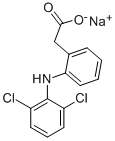
What is Diclofenac sodium?
Description
Diclofenac Sodium is an inhibitor of Cox-1 and Cox-2, it have been used in the treatment of pain associated with osteoarthritis, rheumatoid arthritis, and ankylosing spondylitis.
Chemical properties
Off-White Crystalline Solid
Originator
Voltaren,Fujisawa,Japan,1974
The Uses of Diclofenac sodium
Diclofenac sodium is a nonsteroidal anti-inflammatory compound and cyclooxygenase (COX) inhibitor. Oxidation of diclofenac sodium produces the metabolite 4'-hydroxy diclofenac) which demonstrates specific inhibition of Cox-2. Inhibition of Cox by diclofenac and 4'-hydroxy diclofenac suppresses prostaglandin E2 synthesis, producing anti-inflammatory and analgesic effects. Diclofenac is also shown to stabilize the native tetrameric conformation of transthyretin (TTR) fibrils, preventing the formation of insoluble amyloidogenic TTR deposits. Diclofenac Sodium is a substrate of CYP2C9. It is also used as an inhibitor of Cox-1 and Cox-2.
Definition
ChEBI: Diclofenac sodium is the sodium salt of diclofenac. It contains a diclofenac(1-).
Manufacturing Process
Four grams of N-chloroacetyl-N-phenyl-2,6-dichloroaniline and 4 grams of aluminum chloride are well mixed together and heated for 2 hours at 160°C. The melt is cooled and poured onto about 50 grams of ice while it is still warm. The oil which separates is dissolved in 50 ml of chloroform, the chloroform solution is washed with 10 ml of water, dried over sodium sulfate and concentrated under 11 torr. The residue is distilled. The 1-(2,6- dichlorophenyl)-2-indolinone melts at 126°-127°C. A solution of 186 grams of 1-(2,6-dichlorophenyl)-2-indolinone in 660 ml of ethanol and 660 ml of 2 N sodium hydroxide solution is refluxed for 4 hours. The solution is then cooled and left to stand for 4 hours at 0°-5°C. The crystals which form are filtered off and recrystallized from water. Diclofenac sodium melts at 283°-285°C. The yield is 97% of theoretical, according to US Patent 3,558,690.
brand name
Solaraze (Bioglan); Voltaren (Novartis);Aflamin;Alfamin;Allvoran;Artren;Blesin;B-voltaren;Cgp 9194;Chlorgyl;Ct-diclo;Dichloronic;Diclo attritin;Diclo spondril;Diclo-attritin;Diclo-burg;Diclo-phlohont;Diclo-puren;Diclo-recip;Dicloreum;Diclo-spondyril;Diclo-wolf;Dolobasan;Dolotrem;Doragon;Duravolten;Duvavotten;Feloran;Fenoflam;Flogofenac;Flogogenac;Forgenac;Inflamac;Klast;Monoflam;Myogit;Neuro-effekton;Neurofenac;Neuro-voltaren;Neviodin;Olfen;Panamor;Rewodina;Rheumalgen;Rheumavincin-n;Seecoren;Shignol;Silino;Sofarin;Thicataren;Toryxil;Tsudomin;Voltarene.
Therapeutic Function
Antiinflammatory
World Health Organization (WHO)
The World Health Organization currently has no information to suggest that diclofenac is less safe than other widely available non-steroidal antiinflammatory substances of this type, or that children are particularly liable to react adversely. It is registered in many countries in several dosage forms, including a 12.5 mg suppository indicated for juvenile arthritis.
Biochem/physiol Actions
Standard NSAID and cyclooxygenase (COX) inhibitor. Major metabolites are 4′-hydroxydiclofenac and 5′-hydroxydiclofenac. Has been used as substrate selective for CYP2C9.
Clinical Use
Diclofenac sodium is indicated for the treatment of rheumatoid arthritis, osteoarthritis, and ankylosing spondylitis.
Side Effects
Diclofenac sodium is used for the symptomatic relief of rheumatoid arthritis and osteoarthritis, including degenerative joint disease of the hip. Gastrointestinal problems (ulceration and bleeding) and adverse CNS reactions (dizziness and headache) are the most commonly encountered adverse effects.
Synthesis
Synthesis: Acylation of N-phenyl-2,6- dichloroaniline with chloroacetyl chloride gives the corresponding chloroacetanilide, which is fused with aluminum chloride to give 1-(2,6- dichlorophenyl)-2-indolinone. Hydrolysis of the indolinone with dilute aqueous-alcoholic sodium hydroxide affords the desired sodium salt directly.
Drug interactions
Potentially hazardous interactions with other drugs
antagonism of hypotensive effect; increased risk of
nephrotoxicity and hyperkalaemia.
Analgesics: avoid concomitant use of 2 or more
NSAIDs, including aspirin (increased side effects);
avoid with ketorolac (increased risk of side effects
and haemorrhage).
Antibacterials: possibly increased risk of convulsions
with quinolones; concentration reduced by
rifampicin.
Anticoagulants: effects of coumarins and
phenindione enhanced; possibly increased risk of
bleeding with heparins, dabigatran and edoxaban -
avoid long term use with edoxaban; increased risk of
haemorrhage with IV diclofenac - avoid.
Antidepressants: increased risk of bleeding with
SSRIs and venlaflaxine.
Antidiabetic agents: effects of sulphonylureas
enhanced.
Antiepileptics: possibly increased phenytoin
concentration.
Ciclosporin: may potentiate nephrotoxicity;
concentration increased by ciclosporin.
Cytotoxics: reduced excretion of methotrexate;
increased risk of bleeding with erlotinib.
Metabolism
Diclofenac sodium undergoes first-pass metabolism and It is then excreted in the form of glucuronide and sulfate conjugates, mainly in the urine (about 60%) but also in the bile (about 35%). then extensively metabolised to 4′-hydroxydiclofenac, 5-hydroxydiclofenac, 3′-hydroxydiclofenac, and 4′,5-dihydroxydiclofenac by glucuronidation of the intact molecule or more commonly by single and multiple hydroxylation followed by glucuronidation.
Storage
Store at RT
Properties of Diclofenac sodium
| Melting point: | 288-290°C |
| Density | 0.781 g/cm3 |
| storage temp. | room temp |
| solubility | H2O: 50 mg/mL |
| form | White solid |
| pka | 4(at 25℃) |
| color | White to Almost white |
| Water Solubility | Soluble in water to 50mg/ml. |
| Merck | 14,3081 |
| Stability: | Stable. |
| InChI | InChI=1S/C14H11Cl2NO2.Na/c15-10-5-3-6-11(16)14(10)17-12-7-2-1-4-9(12)8-13(18)19;/h1-7,17H,8H2,(H,18,19);/q;+1/p-1 |
| CAS DataBase Reference | 15307-79-6(CAS DataBase Reference) |
Safety information for Diclofenac sodium
| Signal word | Danger |
| Pictogram(s) |
 Skull and Crossbones Acute Toxicity GHS06  Health Hazard GHS08  Environment GHS09 |
| GHS Hazard Statements |
H301:Acute toxicity,oral H372:Specific target organ toxicity, repeated exposure H411:Hazardous to the aquatic environment, long-term hazard |
| Precautionary Statement Codes |
P201:Obtain special instructions before use. P202:Do not handle until all safety precautions have been read and understood. P260:Do not breathe dust/fume/gas/mist/vapours/spray. P264:Wash hands thoroughly after handling. P264:Wash skin thouroughly after handling. P273:Avoid release to the environment. P301+P310:IF SWALLOWED: Immediately call a POISON CENTER or doctor/physician. |
Computed Descriptors for Diclofenac sodium
| InChIKey | KPHWPUGNDIVLNH-UHFFFAOYSA-M |
| SMILES | C1(=CC=CC=C1CC([O-])=O)NC1=C(Cl)C=CC=C1Cl.[Na+] |
Diclofenac sodium manufacturer
Dr .Silviu Pharmachem Pvt. Ltd.
Rainbow Pharma Agencies
New Products
4,4-Difluoropiperidine hydrochloride tert-butyl 9-methoxy-3-azaspiro[5.5]undecane-3-carboxylate Indole Methyl Resin N-Isopropylurea N,N-Dicyclohexylcarbodiimide(DCC) MELDRUMS ACID 5-METHYLISOXAZOLE-4-CARBOXYLIC ACID Magnessium Bis glycinate Zinc ascorbate 1-bromo-2-butyne 2-acetamidophenol 9(10H)-anthracenone Erythrosin B, 4-Piperidinopiperidine 2-((4-morpholinophenylamino) (methylthio) methylene) malononitrile 2,4-dihydroxybenzaldehyde 3-(4-morpholinophenylamino)-5-amino-1H-pyrazole-4-carbonitrile Methyl 2-methylquinoline-6-carboxylate 2,6-dichloro-4-nitropyridine 4-Bromo-2-chlorobenzonitrile 2-(benzylamino)acetic acid hydrochloride 4-(tert-Butoxycarbonylamino)but- 2-ynoic acid 3,4-dihydro-2H-benzo[b][1,4]dioxepine 1-Phenyl-1-cycloprppanecarboxylicacidRelated products of tetrahydrofuran
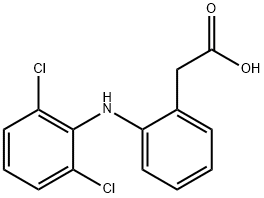
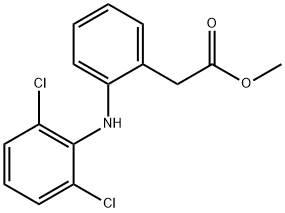
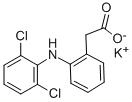




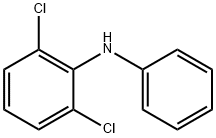
You may like
-
 Diclofenac Sodium 99%View Details
Diclofenac Sodium 99%View Details -
 Diclofenac Sodium 99%View Details
Diclofenac Sodium 99%View Details -
 15307-79-6 95-99%View Details
15307-79-6 95-99%View Details
15307-79-6 -
 Diclofenac sodium 95% CAS 15307-79-6View Details
Diclofenac sodium 95% CAS 15307-79-6View Details
15307-79-6 -
 Diclofenac sodium salt CAS 15307-79-6View Details
Diclofenac sodium salt CAS 15307-79-6View Details
15307-79-6 -
 Diclofenac Sodium ApiView Details
Diclofenac Sodium ApiView Details
15307-79-6 -
 Diclofenac Sodium BP API, 25Kg BagView Details
Diclofenac Sodium BP API, 25Kg BagView Details
15307-79-6 -
 Aceclofenac EP Impurity A, API Impurity, 25mg, Lab GradeView Details
Aceclofenac EP Impurity A, API Impurity, 25mg, Lab GradeView Details
15307-79-6
